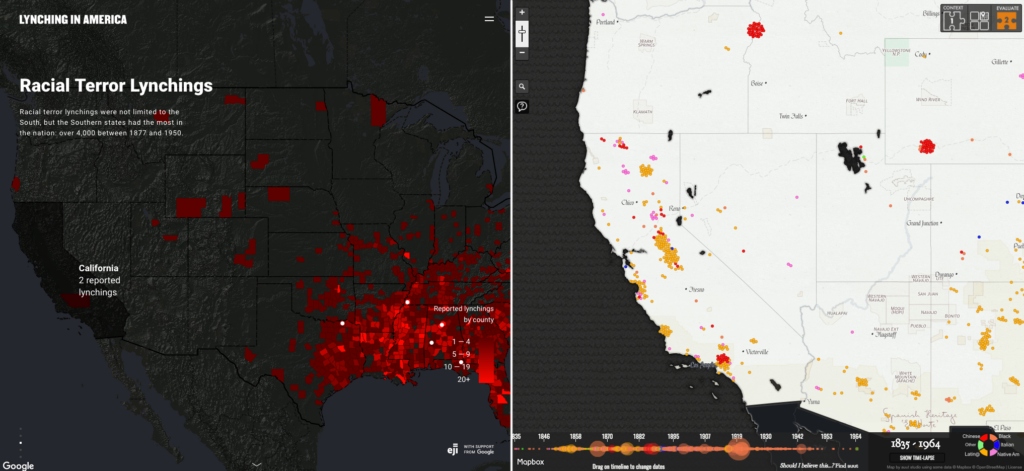The period of American History ranging from 1877 to 1968 was a violent and politically charged time in our nation’s history. Following the end of the civil war, the plan of Reconstruction under Andrew Johnson fell of from Lincoln’s inital plan and failed to properly address racial tensions in the south. Following the emancipation of former slaves, African Americans were able to practice their constitutional right of voting for the canidates of their choice. At the same time however, white suprimacist across the south began to form groups to fight against this right. One of their many acts aganst African Amricans was voter intemination done to prevent racial and ethnic minorites from voting across the south.

One of the many violent acts these groups commited was a practice called lynching. During the period of Reconstruction, lynching was used as a common tactic by the KKK to scare and prevent African Americans from going out and voting. This map titled “Racial Terror Lynchings” from the article titiled “Racism in the Machine: Visulization Ethics in Digital Humanities Projects.” This resource gives an insightful overview of the violence and persecution African Americans faced across the south from the years of 1877 to 1950. The map allows you to find specific data on a state or region where lynchings occured during this period. From the evidence presented on the map, we can see that ynchings were more common in the “deep south” Alabam, Missippi, Louisiana, and Georgia. We know from historical records that groups such as the KKK had more influence in the “deep south” than anywhere else in the country. However, the map also shows that lynching wasn’t excluively done by white supremacist groups rather, it transitioned during the period of Jim Crow.
With the end of Reconstruction in 1877, governments across the south began to from laws that actively kept African American excluded from regular society. These laws would become known as the “Jim Crow Laws” and would be enforced across the south well into the 1960s. During this time, African Americans became targets of racial mob violence during periods of political turmoil and when an African American faced a trial for a crime against a white person. During particularly violent racial riots enitre African American communities were detroyed and its people displaced. Lynching (as seen in the map above) was used by whites to excute African Americans they viewed guilty.

What I really liked about the article provided in the course syllabus was it showed how widespread these riots were. Often, in history class in high school we are taught that racial violence was only occuring in the south and nowehere else in the United States. I can understand why… considering you can cover so much in a high school hitory class. However, it gives an incomplete picture of the reality of the United States during this period of violence and tension. Racial violence in the West Coast of the United States is often overlooked/not discussed as much when we discuss this period of United States History. (As the above map on the right shows) mob violence against ethnic groups ocured in major cities across California and the Western United States. One of the tensions in the west coast was the increasing number of immigrants arriving from the east. White suprimacist and “natavist” groups attacked these immigrants which is presenetd on the map.
A story that is often overlooked during this time period was a form of resistance by an African American during the time of Jim Crow. His name was Monroe Nathan Work who during his time in Savannah, Georgia, witnessed the first segregation laws passed during Jim Crow. While living in Savannah he woud marry a school teacher named Florence Hendrickson, together they would work together in documenting lynching, documenting lack of resources in African American school, sgregation in their community, and pushed for better living conditions for African Americans. Together the two of them would create a program called “Nego Health Week” which was designed to promote healthy living in African Amercian comunities.


Nicely done Harrison – this blog builds on your own understanding of the Jim Crow south to flesh out the argument in the reading. I wouldn’t say this is the deepest reflection possible of this reading, but its solid.